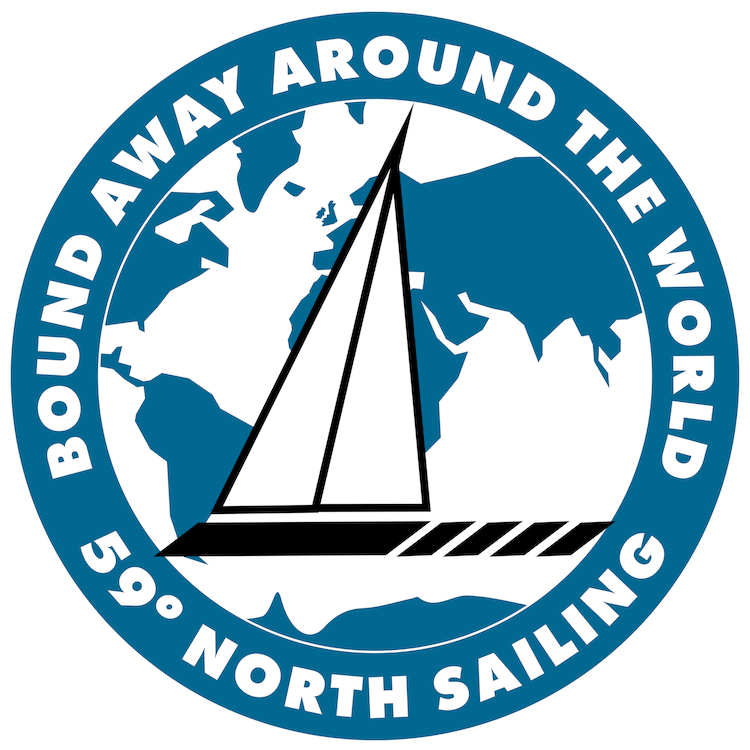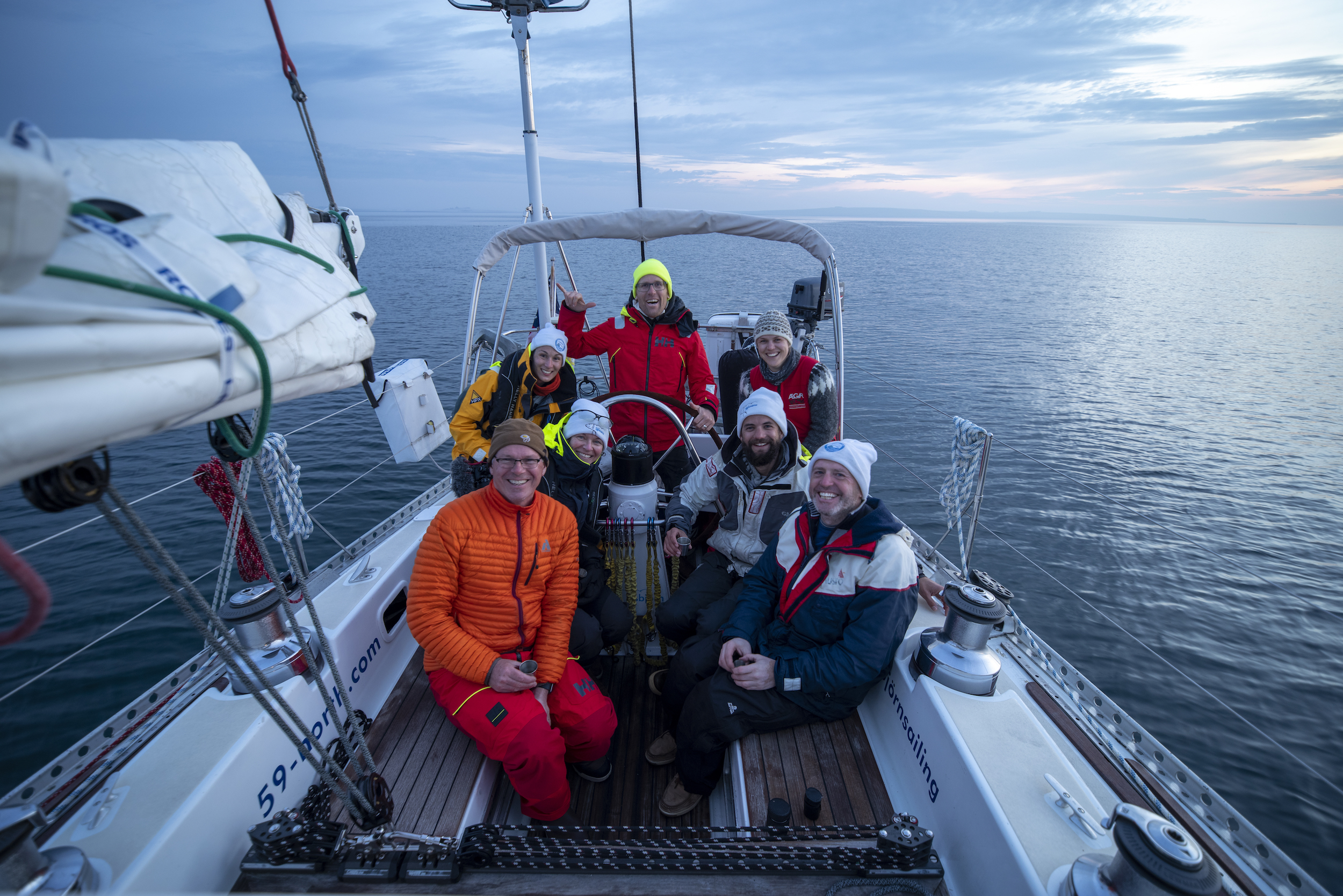Sophie & her watch mate Rob driving Isbjorn through the North Sea.
Note from Andy & Mia: Sophie sailed with us on Isbjorn from Sweden to Scotland in May 2018, our first passage of the Arctic season. She's a 30-something from France who lives in Stockholm with her partner Ryan, another 30-something from Iowa. They recently bought a Beneteau & are about to start a cruise from Stockholm to the Med, their first. Sophie came with us, like many do, to get some experience before setting out on their own. Here, in her own words, is what she learned.
What I've Learned from my First Offshore Passage
It's been over a week since I've come home from Scotland. After a week at sea, four days in Kirkwall, Orkney, and 2 days in Aberdeen (mostly spent in my hotel room), coming home required some adjusting.
At the time of writing, we are two days away from moving on Polar Seal, and barely taking any breaks.
But before I go lose myself in the whirlwind it is to move on the boat, I wanted to reflect on what I learned during my very first ocean passage. This blog post is as much for the readers as it is for me to remember some of this passage most valuable lessons.
Isbjorn flying on a close reach in the North Sea en route to Scotland.
When Andy and Mia told us that they had a spot available on Isbjörn between Orkney and Marstrand, I saw a once in a lifetime opportunity to learn from very experienced people in a fun environment. At that time, I had zero experience of offshore sailing. I had never sailed on another boat than ours (and the one we learned on), and barely sailed with anyone else but Ryan.
Andy and Mia are super cool, and I knew the experience would also be tons of fun. I was not disappointed!!! I came home a much more confident sailor. It's also confirmed that while sailing isn't always easy and I don't enjoy every aspect of it (see point number 2), I'm truly in love with the act of traveling with the wind.
It would take a book to detail every single thing that I learned during our passage. I learned how to rig a boom preventer, I'm far better at steering in all kind of conditions, I understand weather forecasts and how to interpret them a lot better, ... The list is LONG, and the experience was humbling.
So I've shortened it to what stroke me the most, and this is what I've come up with.
Different boats are good at different things.
That would sound logical, right? But for me, steering Isbjörn was a AHAAAAA moment.
I hadn't considered how different types of hull go through the water. That's because the only boats I've ever sailed are: Makora, a Jeanneau Sun Odyssey 36, Polar Seal, our Beneteau Oceanis 40, and Isbjörn, a Swan 48. I didn't even reflect over how design impacts the sailing performance (a boat is a boat, riiiight?).
Isbjorn at rest in Kirkwall, Orkney after the passage.
Polar Seal has a much flatter hull than Isbjörn. It means that Isbjörn slices the waves, whereas Polar Seal jumps over the waves and crashes in the water making the whole boat vibrate. Polar Seal is a nice cruising boat, Isbjörn is a true ocean sailor. I love both :)
Seasickness, my friend...
By now, probably everyone reading this know that I had a bad case of seasickness during the first leg of our Marstrand-Orkney sail to Skagen in Denmark.
I immediately went to the helm when I started to feel the first signs of nausea. I ate a sandwich that Mia graciously prepared me. I ate ginger. I covered myself with some extra layer and stared at the horizon. It all did a good job at postponing the process, but I lost the battle when I started to feel drowsy and laid down in the cockpit.
A seasick Sophie...
I had obviously overestimated my tolerance to seasickness.
I did not even think about bringing seasickness medicine with me on that trip (mistake number 1). I also did not make my warm gear and foul weather gear accessible enough. It was all buried in my bag that was located at the very end of the V-berth, which the waves had made inaccessible. The boat was jumping up and down, and there was no way I was gonna go down in the cabin to fetch my clothes. Mistake number 2.
As I battled with nausea and drowsiness, my mind wouldn't stop throwing at me reminiscences of the worst smells I had ever experienced: engine oil, microwaved fish, the smell of the toilet when Ryan ate something funny, ect.
I also REALLY NEEDED TO PEE. I needed to pee so bad. But I couldn't go down to the head. I couldn't picture myself contorsioning down in the cabin to get my lifejacket off, my bibs foul weather jacket and my bibs while fighting nausea. And sitting on the toilet to pee? Oh Boy. On the Ben's Sea State scale, we were at a two-legs-brace level, at least.
How I'll deal with seasickness in the future:
Make my gear accessible: foulies, hat, gloves, hot pads.
Take the seasickness medicine BEFORE the sail, so it kicks in.
Stay warm.
Go pee whenever I can. Seriously, not being able to go pee was the worse part of it. At my lowest point, I thought I was going to pee myself.
Eat food: low blood sugar make the seasickness process go very fast
Take the helm. I did that for 30 minutes, it did postpone the process.
Whatever makes me comfortable. It seriously is a disgusting condition.
Nice smells? This one will be my next try. I'll have some lavender oil with me...
The value of experimenting in a safe environment.
I'm a strong advocate of "learning by doing" and "figuring things out as we go". I will plead guilty to watching a lot of Youtube and thinking to myself that this sailing thing was going to be ok. Oh boy.
I'm glad that Ryan and I didn't jump on the cruising lifestyle. We took a course, we bought Polar Seal and we built experience over the course of 2 years. It took us 3 years total between making a decision and leaving the dock.
Sophie driving Isbjorn by the compass on a sunny North Sea day.
And I'm really glad I did my first offshore passage before leaving the dock on our boat with a very experimented captain and crew. We sailed out of my comfort zone: in the waves, in the dark, in all kind of wind situation, I walked to the foredeck in the waves to rig a boom preventer....
Being surrounded by experienced sailors allowed me to experiment outside of my comfort zone while feeling safe.
I came home a lot more mature as a sailor, and a lot more confident. Am I done learning? Hell no, no one ever is. But I feel I have more tools to develop my skills while not being petrified by the enormity of the task.
So apprentice sailors out there, I'm no one to tell you what to do, but if you have the opportunity: sail with people who know what they do! Andy and Mia take crew on Isbjörn and are really great teachers.
The crew at our landfall in Orkney at dawn, following the successful passage! From left to right - Front: Brian, Susan, Ben, Rob; Back: Sophie, Andy, Mia.
Doing an ocean passage on their boat and spending 10 days observing how they operate Isbjörn while listening to their stories gave me invaluable insights on how to operate my own sailboat.
I'm truly grateful for the opportunity I had to do a passage with them, and I can't recommend enough anyone to join their crew!
The value of taking crew offshore.
For most sailors, it would also sound obvious that you might want to take crew on longer passage. But when we started thinking about how we would do our offshore passages, I was opposed to the idea of taking on crew.
I didn't feel comfortable with the idea of taking people we would barely know and live with them in close quarters for an extended period of time. I thought a passage would be a moment that I wanted to share with Ryan only.
Oh boy did I change my mind after my first ocean passage.
The value of a good watch system:
First off, being on and off watch is exhausting. Ryan and I did 3 hours watch on and off during our 35 hours sail between Stockholm and Kalmar, and we arrived in Kalmar like zombies. No good.
On Isbjörn, we were rotating 4-hour watches between 3 watch teams. We had:
8AM to 12PM
12PM to 4PM
4PM to 6PM
dinner for everyone at 6PM
6PM to 8PM
8PM to 12AM
12AM to 4AM (that one stings a little ;) )
That watch system guaranteed that you would be on a different set of watches every day. No one had to take the "dog watch" (12AM to 4AM) every night, as we were all rotating.
We also had 8 hours between watches at least once a day, and that is extremely valuable when you adjust to life at sea!
Watch buddies FTW!
Having a watch buddy also made the experience a lot more pleasant. I really enjoyed the company of my watchmate, Rob. We would take turns at the helm every half an hour, and our watches would go relatively fast.
With crew onboard, it also means that it's easier to have company. Being only two onboard, the person off-watch usually will go sleep, and we found yourself alone at the helm most of the time. Nothing wrong with that, but I do enjoy having company in the cockpit!
3 years ago, when we were total novices, we didn't know anyone who sailed. Now, we have a little network of sailor friends who we feel we would really enjoy sailing with and have with us onboard.
During our sail between Marstrand and Orkney, the crew we sailed with was lovely and they are all invited to come sail with us on Polar Seal!
Rob helming while Sophie films for her & Ryan's YouTube channel.
Across the North Sea Video
Sophie filmed her trip across the North Sea for her and Ryan's YouTube channel. Full video below:
Crossing the North Sea between Marstrand (Sweden) and Orkney (Scotland): Check! Ryan and I had no offshore sailing experience. Now, I do! Last week, I crossed the North Sea with Andy and Mia from 59 North Sailing on Isbjörn... and without Ryan :) Andy and Mia offer crew space on their boat, Isbjörn, a beautiful Swan 48.









